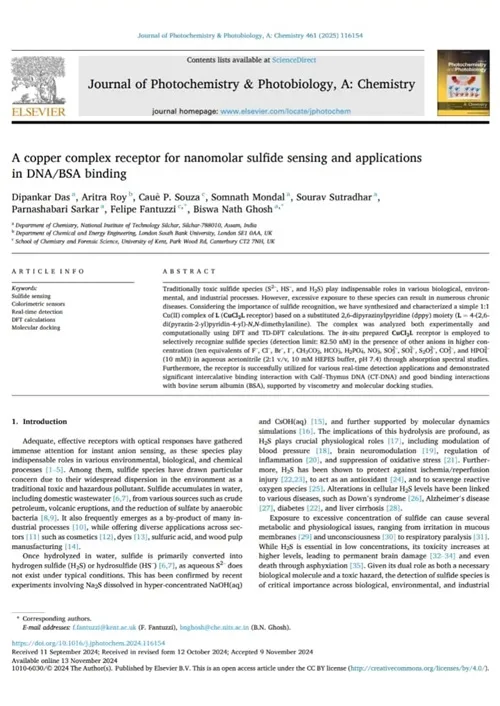Authors
Dipankar Das, Aritra Roy, Cauê P. Souza, Somnath Mondal, Sourav Sutradhar, Parnashabari Sarkar, Felipe Fantuzzi, and Biswa Nath Ghosh
DOI
10.1016/j.jphotochem.2024.116154
Abstract
Traditionally toxic sulfide species (S2–, HS–, and H2S) play indispensable roles in various biological, environmental, and industrial processes. However, excessive exposure to these species can result in numerous chronic diseases. Considering the importance of sulfide recognition, we have synthesized and characterized a simple 1:1 Cu(II) complex of L (CuCl2L receptor) based on a substituted 2,6-dipyrazinylpyridine (dppy) moiety (L = 4-(2,6-di(pyrazin-2-yl)pyridin-4-yl)-N,N-dimethylaniline). The complex was analyzed both experimentally and computationally using DFT and TD-DFT calculations. The in-situ prepared CuCl2L receptor is employed to selectively recognize sulfide species (detection limit: 82.50 nM) in the presence of other anions in higher concentration (ten equivalents of F–, Cl–, Br–, I–, CH3CO2–, HCO3–, H2PO4–, NO3–, SO32–, SO42–, S2O32–, CO32–, and HPO42– (10 mM)) in aqueous acetonitrile (2:1 v/v, 10 mM HEPES buffer, pH 7.4) through absorption spectral studies. Furthermore, the receptor is successfully utilized for various real-time detection applications and demonstrated significant intercalative binding interaction with Calf–Thymus DNA (CT-DNA) and good binding interactions with bovine serum albumin (BSA), supported by viscometry and molecular docking studies.
